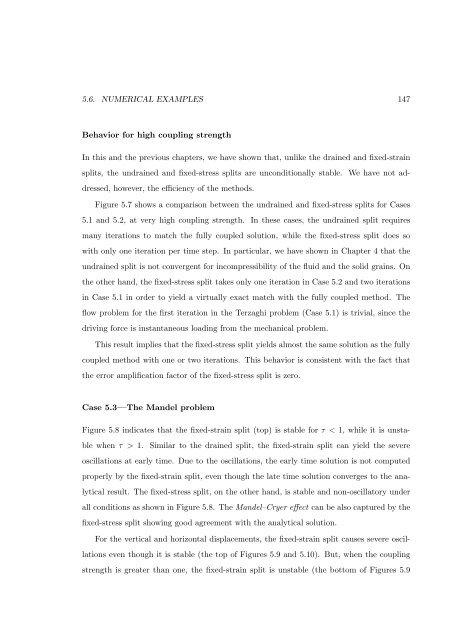Sequential Methods for Coupled Geomechanics and Multiphase Flow
Sequential Methods for Coupled Geomechanics and Multiphase Flow
Sequential Methods for Coupled Geomechanics and Multiphase Flow
You also want an ePaper? Increase the reach of your titles
YUMPU automatically turns print PDFs into web optimized ePapers that Google loves.
5.6. NUMERICAL EXAMPLES 147<br />
Behavior <strong>for</strong> high coupling strength<br />
In this <strong>and</strong> the previous chapters, we have shown that, unlike the drained <strong>and</strong> fixed-strain<br />
splits, the undrained <strong>and</strong> fixed-stress splits are unconditionally stable. We have not ad-<br />
dressed, however, the efficiency of the methods.<br />
Figure 5.7 shows a comparison between the undrained <strong>and</strong> fixed-stress splits <strong>for</strong> Cases<br />
5.1 <strong>and</strong> 5.2, at very high coupling strength. In these cases, the undrained split requires<br />
many iterations to match the fully coupled solution, while the fixed-stress split does so<br />
with only one iteration per time step. In particular, we have shown in Chapter 4 that the<br />
undrained split is not convergent <strong>for</strong> incompressibility of the fluid <strong>and</strong> the solid grains. On<br />
the other h<strong>and</strong>, the fixed-stress split takes only one iteration in Case 5.2 <strong>and</strong> two iterations<br />
in Case 5.1 in order to yield a virtually exact match with the fully coupled method. The<br />
flow problem <strong>for</strong> the first iteration in the Terzaghi problem (Case 5.1) is trivial, since the<br />
driving <strong>for</strong>ce is instantaneous loading from the mechanical problem.<br />
This result implies that the fixed-stress split yields almost the same solution as the fully<br />
coupled method with one or two iterations. This behavior is consistent with the fact that<br />
the error amplification factor of the fixed-stress split is zero.<br />
Case 5.3—The M<strong>and</strong>el problem<br />
Figure 5.8 indicates that the fixed-strain split (top) is stable <strong>for</strong> τ < 1, while it is unsta-<br />
ble when τ > 1. Similar to the drained split, the fixed-strain split can yield the severe<br />
oscillations at early time. Due to the oscillations, the early time solution is not computed<br />
properly by the fixed-strain split, even though the late time solution converges to the ana-<br />
lytical result. The fixed-stress split, on the other h<strong>and</strong>, is stable <strong>and</strong> non-oscillatory under<br />
all conditions as shown in Figure 5.8. The M<strong>and</strong>el–Cryer effect can be also captured by the<br />
fixed-stress split showing good agreement with the analytical solution.<br />
For the vertical <strong>and</strong> horizontal displacements, the fixed-strain split causes severe oscil-<br />
lations even though it is stable (the top of Figures 5.9 <strong>and</strong> 5.10). But, when the coupling<br />
strength is greater than one, the fixed-strain split is unstable (the bottom of Figures 5.9
















